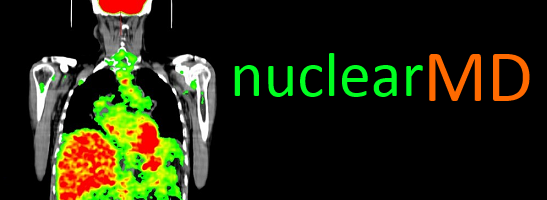Metastatic Prostate Cancer
A 65 year old male presented with low back pain and weight loss. CT scan of the abdomen and pelvis showed moth eaten appearance of T12 vertebral body and bulky retroperitoneal, bilateral iliac and left inguinal lymphoadenopathy, concerning for metastatic disease, without any definite evidence of the primary.
FDG PET/CT demonstrated extensive hypermetabolic lymphadenopathy in the left supraclavicular, mediastinal, and retroperitoneal region consistent with metastatic disease. Widespread hypermetabolic bone metastases were also seen. Focal hypermetabolism was also seen in the prostate, with a maximum standardized uptake value (SUV) of 5.6. The PSA one month ago was elevated at 11.2 ng/ml. Metastatic poorly differentiated carcinoma was found on FNA biopsy of the left supraclavicualar node. Immunohistochemistry showed focal staining with TTF-1 and rare cells staining with PSA and synaptophysin with negative staining for CK7, CK20, CEA, p504, CDX2, CD20 and CD56, a pattern seen in small cell carcinoma of the prostate. Prostate biopsy confirmed adenocarcinoma with a Gleason’s score of 5+4=9.




PET/CT is not performed routinely to diagnose or stage prostate cancer, since the majority of prostate cancers are not FDG avid (1, 2). PET/CT although is indicated in patients with metastatic disease without a known primary. Focal hypermetabolism in the prostate is suspicious for neoplasm and should be further evaluation with tissue sampling to rule out malignancy. In patients with FDG avid prostate cancer, whole body PET/CT has been shown to provide additional information by identifying metastatic lesions (in soft tissues, lymph nodes, and skeleton) with one single whole body imaging procedure (3,4).
1: Ishiguro T, Kimura H, Araya T, Minato H, Katayama N, Yasui M, Kasahara K, Fujimura M. Eosinophilic pneumonia and thoracic metastases as an initial manifestation of prostatic carcinoma. Intern Med. 2008;47(15):1419-23.
2: Von Schulthess GK, Hany TF. Imaging and PET-PET/CT imaging. J Radiol. 2008 Mar;89(3 Pt 2):438-47.
3: Liu Y. FDG PET-CT demonstration of metastatic neuroendocrine tumor of prostate. World J Surg Oncol. 2008 Jun 19;6:64.
4: Jadvar H. Prostate cancer: PET with 18F-FDG, 18F- or 11C-acetate, and 18F- or 11C-choline. J Nucl Med. 2011 Jan;52(1):81-9.
This case was prepared by Dr. David He BCM
